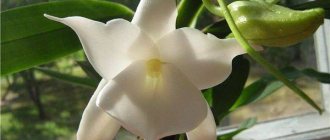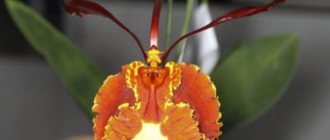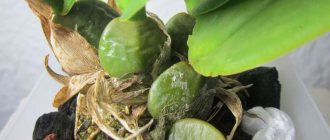The Orchid family includes several genera:
- oncidium;
- tolumnia;
- psychopsis;
- Odontoglossums.
Most of them grow on trees, that is, they belong to epiphytes. A small number of species grow on rocky, rocky soils - these are lithophytes.
The natural habitat of the genera in question is a warm, moderately humid climate, with diffuse sunlight.
Garden and indoor varieties and hybrids originated from wild representatives :
- tropical;
- forest species from the central, middle and northern latitudes (136 species - Lyubka bifolia, orchid, lady's slipper, bulbous calypso, swamp moth, spreading orchis).
Northern forest orchids are currently included in the Red Book. Their roots produce a fungus - mycorrhiza, which is involved in the metabolic process. Replanting forest orchids is problematic.
Garden crops develop and bloom well in conditions that are balanced for them. Next, you will receive comprehensive information about the varieties of orchids: Leopard, Bat, Ophrys, Psychopsis.
Leopard orchid
While preparing information on this topic, we were never able to determine exactly what people mean when searching for the Leopard Orchid plant. There are several possible variants of plants that may be implied by this name:
Lily Belamkanda
, the Belamkanda Chinese lily, which is scientifically considered generally an iris (Iris domestica), migrated to our gardens . A perennial with a long flowering period in the garden, it reproduces by self-sowing or dividing the rhizome.
Flower diameter up to 7 cm, flowering period from July to September. The lifespan of an individual flower is 2 hours; when it fades, it curls.
Balakamda sinensis (Iris domestica).
The seed pods form in the fall and resemble blackberries. A young flower can be grown at home and then moved to the garden.
One of the variants of Odontoglossum
Odontoglossums (lat. odontos - “tooth” and glossa - “tongue”) are an epiphytic orchid that emerged from the mountainous regions of Central and South America.
Odontoglossum "Leopard Lily" is shaped like a star. The color of the petals is varied, but the pattern is recognizable, similar to the skin of a leopard. Some varieties have the aroma of lily of the valley or vanilla.
Bicton odontoglossum.
Many species of odontoglossums are used for crossing with other genera (Miltonia, Oncidium) to obtain new hybrids with new colors and scales of flowers. Natural species of Leopard orchids are extremely rare in flower shops.
Orchids in “leopard skins” bloom from October to May on the windowsill at home. The rest period is accompanied by a decrease in temperature to 20 degrees and a decrease in the amount of watering; humidity is kept at least 60%. They are easier to care for compared to other types .
The substrate for transplanting a leopard orchid must necessarily contain bark and peat at a ratio of 3 to 1.
Relatives of leopard orchids are “Tiger orchids”, which belong to the genus Rossioglossum. They are able to bloom from late autumn to late winter.
Ofris
Orchid Ophrys (ancient Greek όφρύς - “eyebrow”) is a perennial herbaceous plant from the orchid family , there are more than 150 varieties. Ofris is protected by the Red Book.
Root tubers have a spherical appearance. The leaves are collected in rosettes. Inflorescences are racemes. The flower looks like an insect, the lip is bright and pubescent.
Ophrys insectiferous.
The growing area is quite wide:
- Mediterranean;
- North Africa;
- Asia Minor;
- Southern and Central Europe.
Insectiferous orchid grows up to 35 cm in height. The insectiferous orchid has a spike-shaped inflorescence and an erect flower. Flowers are like insects that have folded their wings. The leaves are red-brown, and the lip is three-lobed with a bluish spot in the middle. The flowering period of ophris is from June to August.
The bee-bearing ophrys grows up to 45 cm. There are from 3 to 8 rare flowers on the peduncle.
The perianth leaves are pink, the green inner petals are short and velvety. The color of the lip is purple-brown with a yellow-brown spot, and there is a yellow border along the edge.
Ophrys bee-bearing plant blooms from May to June. After flowering, a fruit is formed - a capsule.
Decorative orchids are propagated by seeds.
Ophrys bee-bearing.
Important! When keeping a flower at home, keep in mind that opris is self-pollinating and has cross-pollination.
Ofris's homeland in Russia is located on the Black Sea coast of the Caucasus and in the Caucasus. The plant lives in oak and juniper forests and on limestone screes near the mountains. Ophrys is endangered.
Video with a detailed description of the types of Ofris:
History of creation
The first mentions of orchids appeared at the end of the 17th century in the diaries of the naturalist Georg Rumph, and a scientific description was made in 1825 by Karl Blum. The golden orchid has gained great popularity, and there are many varieties of it, since the plants are easily crossed. Breeding specialists develop new varieties based on the external characteristics of flowers.
Mostly golden or yellow plants are taken.
Psychopsis
Previously, the psychopsis orchid (Greek psyhee - soul, “butterfly” and opsis - “similar”) belonged to the genus Oncidium. Currently, it is a separate genus with its own species and subspecies. The homeland of psychopsis is America, its center and south with a temperate warm climate.
The structure of a psychopsis flower is a copy of a butterfly or moth. The Greek goddess Psyche is often depicted in myth as a fairy with butterfly wings.
The orchid forms unifoliate pseudobulbs with a long peduncle. Large flowers open in a “revolving” type, that is, as the previous one fades.
At home, psychopsis develops and blooms well. A temperature regime is created for them in which the difference between day and night temperatures does not exceed 5-6 degrees. On the windowsill, this genus of orchids can bloom all year round. In nature - from March to October.
Psychopsis orchids have several varieties , below you will learn about the most popular of them.
Papilionaceous
grows up to 28 cm in height It forms oval-round pseudobulbs up to 5 cm, grow closely, often with dirty red spots and specks.
Psychopsis moth.
Each bulb produces one erect leaf up to 23 cm in length. The color of the leaves is matte with veins and red spots.
The flower reaches 15 cm in length.
Kramer's Psychopsis
The epiphyte grows up to 29 cm. Pseudobulbs are formed up to 4 cm, located tightly to each other.
Dark green leaves, sometimes with a marbled pattern, of Kramer's psychopsis (Psychopsis krameriana), up to 25 cm in length, grow on the tops of the pseudobulbs, the leaves are leathery with sharp tips.
The diameter of large flowers is up to 12.5 cm.
Kramer's Psychopsis.
Limminghei (Orchid Psychopsiella limminghei)
Miniature epiphyte , which grows heart-shaped pseudobulbs no more than 2 cm in length. Leaves appear at intervals of 1-2 cm. Thin, light brown-green leaves each up to 4 cm in length with burgundy spots.
The orchid produces up to five 10-centimeter peduncles with a single flower. Flowering according to the “revolving” type. Butterfly flower up to 4 cm in diameter.
Limmynhey.
Sander (Oncidium Sanderae)
A sympodial epiphyte, forming groups of plants, grows no more than 25 cm . Pseudobulbs are matte green, ovoid, up to 4.5 cm in length.
The leaves are leathery, oval, up to 20 cm long at each tip of the bulb. Peduncles are erect, up to 35 cm long. Each arrow produces about 4 flowers up to 15 cm in length , which bloom alternately.
Blooms several months a year.
Psychopsis Sander.
Alba (Psychopsis Kalihii alba)
An epiphyte with a long peduncle up to 120 cm. On each peduncle, 1-2 butterfly flowers of delicate yellow colors with orange spots along the edges are formed.
The diameter of the flower reaches 8 cm, each of them blooms for about two weeks.
Alba.
Video description of the Psychopsis orchid:
Description and photo of the original appearance
The leaves of the orchid are either oblong or broadly lanceolate . The flowers are yellow-white-red in color with small inclusions. The lower part of the leaves is usually covered with numerous small brown spots.
The main distinguishing feature of the flower is the presence of jagged outgrowths, which are located right at the base of the lip. The lip is white with a cream tint and red spots, and its shape is round. At the very base there is a fleshy comb, the peduncle is rather curved, its length is about 30 cm.
See photos of Grammatophyllum speciosum:
The diameter of the flower is about 15 cm, the number of flowers is no more than 9 . The sepals are lanceolate in shape with a downward curved edge, yellow in color and large brown stripes.
Bat plant
Many exotic flowers have unusual shapes and colors. The Bat flower itself is an inflorescence. The bat is sometimes called the "Devil Flower", "White Dove" or "Bat Flower".
The unique plant has nothing in common with orchids and belongs to the Tacca family , which grow in life in the south and east of Asia, India, Malaysia and the south of America with varied climatic conditions:
- open or shaded bushes;
- seashore and savannah;
- rainforests and high mountains.
Tacca is a perennial plant with creeping or tuberous roots that can grow on any soil: sand, stones, gravel, loam, clay, limestone and even volcanic rocks. The height of the plant is from 40 to 100 cm, some species stretch up to 3 meters.
Few large basal leaves and inflorescences are formed on the flower. These include only three species; the flowers differ in the upper pair of bracts.
The flowers of Takka Bat in an umbellate inflorescence are bisexual and are located on small pedicels with long thread-like “whiskers”. The spathe consists of four bracts in two circles. The fruit is a berry with seeds up to 5 mm long.
At home, the takka bat is extremely rare. She prefers western and eastern windows, without direct sunlight. Northern window sills will require additional lighting. In the spring and autumn of the Bat, the temperature is maintained within 25 degrees.
Takka "Bat".
Important! Drafts are detrimental to the Bat Taka.
From this video you will learn how to care for Takka the Bat:
Home care
Tropical conditions are created for a tropical beauty on the windowsill. The room temperature is maintained from 20 to 27 degrees. Air humidity is created within 60-80% using spraying and additional containers with water.
Attention! Spray should be done carefully, without getting water into the axils of the leaves.
Lighting is required to be bright, without direct sunlight.
Watering is not a method of hydration. There should be little water in the pot. The next watering is done only after the substrate has dried.
Stress stimulates the orchid to bloom: a sharp decrease in the number of spills and a decrease in air temperature by 5-6 degrees.
For each variety there are separate nuances in content. Before purchasing orchids, you need to study them.
It is best to feed orchids with special fertilizers according to the instructions: little by little, but weekly.
Disease prevention involves strict adherence to watering, humidity, temperature and lighting regimes.
Reproduction
The most effective and easiest way to propagate an orchid is using root shoots . For this, the plant must be about 5 years old. The procedure should be performed 2-3 weeks after flowering. The temperature at the moment of separation of the shoots from the root should be 21-26 degrees.
- Carefully cut off the root shoot.
- Treat the cut area with brilliant green.
- The first watering should be done after a week.
Landing rules
The soil for all varieties of orchids is made water-permeable and breathable. The substrate must contain large elements:
- sand;
- bark;
- moss;
- stones;
- pebbles.
A third of the height of the pot is occupied by drainage. Experienced gardeners recommend using a transparent pot to better control the condition of the root system. Orchids are replanted no more than once every two years using the transshipment method.
Orchid transplantation step by step.
Pest Control
The main pests that eat up the plant are scale insects and aphids . It is very good to treat the leaves of the plant with a soap solution with a small addition of alkali. For aphids, it is useful to treat flowers with water and milk in a ratio of 50 to 50. But it is best to use reliable chemicals for these purposes, which are sold in specialized stores.
Disease prevention - treatment with insecticide once a month. There should be heat outside the window or dry air in the room.
The peculiarity of the orchid is that it really does not like any movement. As a last resort, if you still had to move the pot with the orchid, then you definitely need to return this container to its original place.
At the moment, growing Tiger Orchid is very popular and if you follow detailed instructions for caring for this exotic plant, it will delight its owners with its beauty for a long time.











